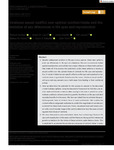Intralocus sexual conflict over optimal nutrient intake and the evolution of sex differences in life span and reproduction
| dc.contributor.author | Hawkes, M | |
| dc.contributor.author | Lane, Sarah | |
| dc.contributor.author | Rapkin, J | |
| dc.contributor.author | Jensen, K | |
| dc.contributor.author | House, CM | |
| dc.contributor.author | Sakaluk, SK | |
| dc.contributor.author | Hunt, J | |
| dc.date.accessioned | 2022-02-17T14:15:22Z | |
| dc.date.available | 2022-02-17T14:15:22Z | |
| dc.date.issued | 2022-01-09 | |
| dc.identifier.issn | 0269-8463 | |
| dc.identifier.issn | 1365-2435 | |
| dc.identifier.uri | http://hdl.handle.net/10026.1/18817 | |
| dc.description.abstract |
<jats:title>Abstract</jats:title><jats:p> <jats:list> <jats:list-item><jats:p>Despite widespread variation in life span across species, three clear patterns exist: sex differences in life span are ubiquitous, life span is commonly traded against reproduction, and nutrition has a major influence on these traits and how they trade‐off. One process that potentially unites these patterns is intralocus sexual conflict over the optimal intake of nutrients for life span and reproduction. If nutrient intake has sex‐specific effects on life span and reproduction but nutrient choice is genetically linked across the sexes, intralocus sexual conflict will occur and may prevent one or both sexes from feeding to their nutritional optima.</jats:p></jats:list-item> <jats:list-item><jats:p>Here we determine the potential for this process to operate in the decorated cricket <jats:italic>Gryllodes sigillatus</jats:italic>. Using the Geometric Framework for Nutrition, we restrict male and female crickets to diets varying in the ratio of protein to carbohydrates and total nutrient content to quantify the effects on life span and daily reproductive effort in the sexes. We then use inbred lines to estimate the quantitative genetic basis of nutrient choice in males and females. We combine the nutrient effects and genetic estimates to predict the magnitude of evolutionary constraint for these traits in each sex. Finally, we present male and female crickets with a much broader range of diet pairs to determine how the sexes actively regulate their intake of nutrients.</jats:p></jats:list-item> <jats:list-item><jats:p>We show that protein and carbohydrate intake have contrasting effects on life span and reproduction in the sexes and that there are strong positive intersexual genetic correlations for the intake of these nutrients under dietary choice. This is predicted to accelerate the evolutionary response of nutrient intake in males but constrain it in females, suggesting they are losing the conflict. Supporting this view, males and females regulate nutrient intake to a common nutrient ratio that was not perfectly optimal for life span or reproduction in either sex, especially in females.</jats:p></jats:list-item> <jats:list-item><jats:p>Our findings show that intralocus sexual conflict over the optimal intake of nutrients is likely to be an important process generating sex differences in life span and reproduction and may help explain why females age faster and live shorter than males in <jats:italic>G. sigillatus</jats:italic>.</jats:p></jats:list-item> </jats:list> </jats:p><jats:p>A free <jats:ext-link xmlns:xlink="http://www.w3.org/1999/xlink" xlink:href="http://onlinelibrary.wiley.com/doi/10.1111/1365-2435.13995/suppinfo">Plain Language Summary</jats:ext-link> can be found within the Supporting Information of this article.</jats:p> | |
| dc.format.extent | 865-881 | |
| dc.language | en | |
| dc.language.iso | en | |
| dc.publisher | Wiley | |
| dc.subject | carbohydrate | |
| dc.subject | evolutionary constraint | |
| dc.subject | genetic correlation | |
| dc.subject | nutritional geometry | |
| dc.subject | protein | |
| dc.subject | sex-specific nutritional optima | |
| dc.title | Intralocus sexual conflict over optimal nutrient intake and the evolution of sex differences in life span and reproduction | |
| dc.type | journal-article | |
| dc.type | Journal Article | |
| plymouth.author-url | https://www.webofscience.com/api/gateway?GWVersion=2&SrcApp=PARTNER_APP&SrcAuth=LinksAMR&KeyUT=WOS:000740538400001&DestLinkType=FullRecord&DestApp=ALL_WOS&UsrCustomerID=11bb513d99f797142bcfeffcc58ea008 | |
| plymouth.issue | 4 | |
| plymouth.volume | 36 | |
| plymouth.publication-status | Published | |
| plymouth.journal | Functional Ecology | |
| dc.identifier.doi | 10.1111/1365-2435.13995 | |
| plymouth.organisational-group | /Plymouth | |
| plymouth.organisational-group | /Plymouth/Faculty of Science and Engineering | |
| plymouth.organisational-group | /Plymouth/Faculty of Science and Engineering/School of Biological and Marine Sciences | |
| plymouth.organisational-group | /Plymouth/Users by role | |
| plymouth.organisational-group | /Plymouth/Users by role/Academics | |
| dcterms.dateAccepted | 2021-12-06 | |
| dc.rights.embargodate | 2022-2-18 | |
| dc.identifier.eissn | 1365-2435 | |
| dc.rights.embargoperiod | Not known | |
| rioxxterms.versionofrecord | 10.1111/1365-2435.13995 | |
| rioxxterms.licenseref.uri | http://www.rioxx.net/licenses/all-rights-reserved | |
| rioxxterms.licenseref.startdate | 2022-01-09 | |
| rioxxterms.type | Journal Article/Review |


